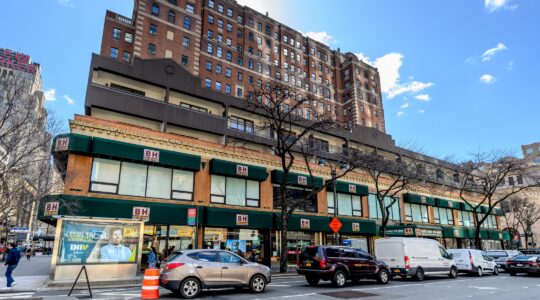There are no people visible in Chris Jones’ large mixed-media collage, “After They Had Left,” one of the first works of art visitors encounter in Hebrew Union College-Jewish Institute of Religion Museum’s current exhibit, “Home(less).”
Jones, a British sculptor, has created an assemblage of rooms and hallways, “furnished” with settings from magazine and book pages, mixing rustic, run-down and fading glamorous styles. It’s as if someone lifted the front façade of a many-floored house, leaving a geometric, urban dollhouse. He includes open windows with views, stairwells and many stories left untold.
“Home. Is it an actuality, a concept, a dream or some combination of these and more?” asks Laura Kruger, who curated the wide-ranging group show.
“Home. Is it an actuality, a concept, a dream or some combination of these and more?”
“Home(less)” features the work of more than 70 artists, all reflecting on the meaning of home and, also, homelessness. They find inspiration, beauty and truth in many places, from biblical interpretation to ritual items, from the Holocaust to current events.
Kruger says that she was not looking for pictures of houses but something more nuanced. Perhaps the most humble and fragile example of home is seen in Heddy Abramowitz’s photograph, “Balcony Sukkah for Two, Jerusalem.” The sukkah, in front of arched windows, is made of bed sheets, topped with palm fronds.
“Home(less)” elicits complex reactions: gratitude for the homes we enjoy; guilt at how easy it is to avert one’s eyes from those who have no homes; silence. The viewer is made ever aware of the thin and porous line between home and homelessness, especially at this time when we have witnessed an increase in refugees around the world forced to leave their homes and, in this country, the extensive and shocking loss of homes due to fire, floods and mudslides.
In an essay in the exhibition catalogue, Alyssa Gray, professor of codes and responsa literature at HUC, writes that both home, whether divine or human, and the loss of home, or exile, are pervasive Jewish themes, and so is the hope that one can go home again.
The themes of the show crisscross images and ideas of beloved homes, destroyed homes, remembered homes, remnants of home, empty nests, asylum seekers, homelands and a nod to home base. But while art shows with messages are often more about the messages, Kruger has collected a lot of very good art for this exhibition.
Kruger, herself a New York treasure, has been curating exhibitions at the HUC Museum for more than 20 years. She’s a great champion of artists whose work touches on Jewish themes. Her selection and presentation of the work enables timely conversation and community engagement with art.
Most, but not all, of the participating artists are Jewish. Kruger likes to be inclusive, and she feels that this theme extends beyond the Jewish community. While she has curated many group shows, she features some artists, like Chris Jones, here for the first time.
David Wander reflects back to biblical text, providing a modern spin to the story of Lot’s wife, depicting her in contemporary dress, turning back to see the destruction of her home, engulfed in flames. Wander explains that she is divorced, looking back, as her biblical namesake did, at the loss of her dreams. “Lot’s Wife” is powerful, full of drama and light.
Exploring global displacement in her piece “Displacement From Home: What to Leave, What to Take,” Linda Stein creates assemblages filled with small objects, pieces of memory that might be the things one saved from a family home, like a tiny silver spoon, stones, scraps of fabric, hand-written notes. Claire Boren’s abstract mixed-media work, “Home 2,” represents the artist’s home during the Shoah, when she and her mother hid in houses, attics and in the forest. They spent three months underground, in a hole dug underneath a barn’s pigsty.
A large cow, with black Hebrew letters on white hide, stands in the center of Mark Podwal’s color print “Most Families Managed to Acquire a Cow,” part of a series he did when he visited the Polish town where his mother was born. The piece was inspired by what he encountered and heard in the town, like the notion that if you owned a cow, you would have had a home. The Nazis burned the town of Dabrowa Bialostocka to the ground.
Kruger speaks of a Jewish responsibility to help the homeless and recognizes that some pieces may make viewers feel uncomfortable. David Zimmerman’s “Last Refuge” is a photograph that looks like a fabric collage. But it is a pile of weathered old clothing covering a hole in the ground where a man lived. Pat Berger’s “Mildred’s World” is an empathetic portrait of a homeless woman who chose the streets over a shelter. In a similar spirit, photographer Joan Roth presents a striking photo essay on the plight of homeless women in New York City, without taking away their dignity.
Hanan Harchol, in a black-and-white print in graphic novel style, “The House He Already Has,” ties together gratitude and having a home. Robert Forman makes his home in a converted 19th-century firehouse in Hoboken, N.J., and uses the technique of yarn painting, learned from the Huichol Indians in Mexico, to create a colorful depiction of this unusual place and its history.
And, Nathan Hilu — at 92, the oldest artist in the show — lives in an assisted living facility on the Lower East Side. His colorful works in crayon, chalk and colored pencil are exuberant New York scenes, one a Shabbat table.
Ritual items include creative and modern mezuzot to be affixed to the doorposts of a home by artists Tobi Kahn and Judy Sirota Rosenthal; two chuppahs that represent spiritual homes; and a pair of tefillin recast. Ken Goldman explains that he always travels with his tefillin, suggesting that they are a portable home connecting back to his actual home and family. In fact, the boxes holding the parchment are known as batim, or homes. In Goldman’s version, the box worn at the top of the forehead is in the shape of a house, chimney and all.
Several artists view Israel as home and homeland, as refuge and also as a place of homelessness. Painting with characteristic energy, wit and vibrant color in “Herzl,” Archie Rand portrays the visionary leader who advocated for a Jewish homeland, based on a photo taken of him in 1901 on the balcony of a hotel in Basel, where the Fifth Zionist Congress was taking place.
The show includes humor too, like Sara Zielinski’s “The Man and Fridge,” a monotype portrait of a checkered kitchen floor and a balding man in his undershorts, helping himself to a drink from the refrigerator in the middle of the night. The scene could only be at home.
“Home(less)” runs through June 29 at the HUC-JIR Museum, 1 W. 4th St., huc.edu.
The New York Jewish Week brings you the stories behind the headlines, keeping you connected to Jewish life in New York. Help sustain the reporting you trust by donating today.




